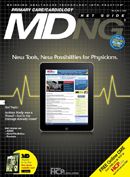Publication
Article
MDNG Primary Care
Editor's picks for this month's best of the Web
It is better to remain silent and be thought a fool than to open one’s mouth and remove all doubt.
- Abraham Lincoln
Retraction Watch
Though it’s a bit shameful that the general public only becomes aware of certain dire life situations because a celebrity has decided to throw their star power behind them, it’s also great that the attention could bring about monetary support and significant change. The unfortunate flip-side of that coin is that these same people become overnight experts on subjects in which it takes the average person many years of study and real-world experience to become a professional.
Actress Jenny McCarthy has been a leading crusader in the vaccination-autism controversy since 2007, two years after announcing that her son had been diagnosed with autism spectrum disorder. Perhaps hers will serve as a cautionary tale for other celebrities looking to debunk medical research now that Andrew Wakefield’s 1998 Lancetstudy linking the onset of autism to the measles, mumps, and rubella vaccine has been retracted (http://hcp.lv/gopUEK).
Unfortunately, the effects of this controversy will be long-lasting. Both the United States and United Kingdom have seen vaccination rates drop to their lowest levels in years, while the incidence of measles and mumps cases is on the rise in both nations (http://hcp.lv/fwQ5Hn). Again, this is what happens when you form the majority of your opinions regarding health care matters by taking the advice of people you see on television.
One party that is doing its part to draw attention to bogus medical research is Retraction Watch, a blog with a very self-explanatory title, that, though they cover the realm of science in general, exerts a good deal of its efforts showcasing retracted research in the medical field.
It sounds like dry stuff, but it is both humorous and personable. When asking why a 2004 study in the Annals of Thoracic Surgerywas retracted, the journal’s editor L. Henry Edmunds replied: “It’s none of your damn business.” Regardless of the site’s liveliness, it does the public and medical community a great service by letting them know when people are falsifying data, plagiarizing, or just being sloppy in their methods.
Politicians make policy decisions based on scientific research; researchers use completed studies as the basis for their theories and work in drug development and trials; these things impact individuals the world over. What could be more important than compiling as much of this knowledge into one place?
Sure, the site could be searchable my research field and focus, but being that it was just started last August and it’s really the only one of its kind out there, Retraction Watch stands out to us as one of the best health care sites on the Internet and something both you and your patients should be checking on a regular basis.
Sights
Down by the Bay, Where the Watermelons Grow
Have you ever seen a bear chasing a bison with badly burned hair? Follow the link and you can check that one off your life’s To Do list.
PC Beat
No Risk, No Reward
Not every medical breakthrough is the result of decades’ worth of incremental steps in hundreds of laboratories. Sometimes it takes a blind, flying leap into the unknown to bring about significant change. Take for example a man who swallowed worm eggs in a desperate attempt to cure his inflammatory bowel disease. A year later, his symptoms had all but disappeared after his body “produced mucus in an effort to expel the works, and the thick fluid coated the man’s intestines, soothing the ulcers in the lining of his colon.” But this story is only one of 13. Check out the rest here.
Google Body
If you don’t have any devices that can utilize the body-exploring mobile apps that you’ve seen featured in the pages of MDNG, check out Google Body, “a detailed 3D model of the human body” that allows you to “peel back anatomical layers, zoom in, click to identify anatomy, or search for muscles, organs, bones, and more. You can also share the exact scene you are viewing by copying and pasting the URL.” Note: you need a Web browser that supports WebGL (Firefox 4, Chrome Beta or Chromium, WebKit nightly, or Safari).
Littleathis, littleathat
Who Wants to See a 300-year-old Watch Found in the Sea?
Here you go.
Apocalypse Survival Guide
The world is going to end one day; that much we know. Whether it will be an alien invasion or an asteroid is anybody’s guess, but mankind has been trying to predict the end of days probably since we first formed societies. We could be in for an interesting two years because depending on whom you believe, the world is going to end on October 21, 2011 (http://hcp.lv/gpSKQP) or December 21, 2012 (http://hcp.lv/fwK1Ff). Pay no mind to the fact that every apocalyptic screed throughout history has been proven wrong by the passage of time (but isn’t that what “they” want you to think?)…one of these could be the one! If indeed the worst comes true, this guide will explain how to use a group of four ships as a floating oasis to protect you against hunger, inclement weather, and marauding zombies.
Space!
Every space mission since 1950 made all pretty like on one map.
If You’re Feeling Existential
Leave it to math to make you feel inconsequential. Calculate the odds of your existence from 10 generations ago and you will find that the chances of you being born were 1 in 6000000000000000000000000000000000000000000000000000000000000000000000000000000000000000000000000. These calculations are more complicated than you think, right down to the likelihood that you were the right kind of sperm (approximately 1% of sperm can even fertilize a woman’s egg!). We’re going to go sit down now and stare at the ceiling.






